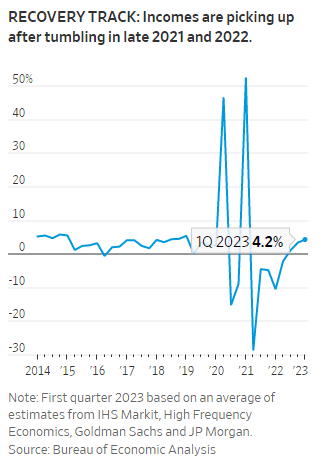
昨年インフレに見舞われた米国の家計が景気を押し上げる/ウォールストリートジャーナルを読む
U.S. Households Lifting Economy After Being Stung by Inflation Last Year
昨年インフレに見舞われた米国の家計が景気を押し上げる
Wage gains, state tax cuts and cost-of-living adjustments are boosting disposable income
賃金上昇、州税減税、生活費調整で可処分所得は増加中
Fresh figures on jobs and prices drove the economy’s surprising vigor this year, joining rising household incomes, consumer resilience and other data that have persuaded investors the Federal Reserve’s battle against inflation is likely to be a longer one than they hoped.
雇用と物価に関する新しい数字が、今年に入ってからの経済の驚くべき活力を後押しし、世帯所得の増加、消費者の回復力、その他のデータとともに、連邦準備制度のインフレとの戦いが期待以上に長引きそうであることを投資家に納得させることとなった。
Layoffs remained historically low last week while supplier prices increased in the year through January by 6%, faster-than-expected but down from 6.5% in December, the Labor Department said Thursday.
労働省が木曜日に発表したところによると、先週、解雇は歴史的な低水準にとどまり、1月までの1年間にサプライヤー価格は6%上昇し、予想を上回ったものの12月の6.5%からは減少した。
In another sign of still-hot labor demand, the department reported earlier this month that hiring surged in January and unemployment fell to a 53-year low.
今月初め、同局は1月に雇用が急増し、失業率が53年ぶりの低水準に落ち込んだと報告した。
Moreover, slowing inflation, pay raises negotiated last year, cost-of-living adjustments for retirees and state tax cuts have lined up to lift consumer purchasing power, fortifying spending and economic growth at a time when many analysts were predicting a slowdown or even recession. This marks a turnabout for households that were squeezed last year by high inflation, climbing interest rates and the end of Covid-related federal relief programs.
さらに、インフレ率の低下、昨年の賃上げ交渉、退職者の生活費調整、州税減税などが、消費者の購買力を高め、多くのアナリストが景気減速や後退を予測していた時期に、消費と経済成長を強固にする要因となっているのである。昨年は、高いインフレ率、金利の上昇、連邦政府によるCovid関連の救済プログラムの終了によって、家計が圧迫されましたが、これは好転を意味すると思われる。

Among the recent evidence: Retail sales rebounded in January, rising 3% on the month following back-to-back monthly declines in November and December.
最近の証拠としては 小売売上高は、11月、12月と連続して前年同月を下回ったが、1月は前年同月比3%増となり、回復基調を示した。
Stocks fell Thursday after the new data boosted concerns the Fed would have to raise interest rates higher for longer than otherwise to combat inflation by slowing the economy. The S&P 500 dropped 1.3%. The Dow Jones Industrial Average slipped 1.3%, while the tech-focused Nasdaq Composite lost 1.8%. Government-bond yields rose, with the yield on the benchmark 10-year U.S. Treasury note increasing to 3.842% Thursday from 3.806% Wednesday. Bond prices fall when yields climb.
この新しいデータによって、FRBが経済を減速させることによってインフレに対抗するために、他の方法よりも長く金利を高くしなければならないという懸念が高まったため、株価は木曜日に下落した。S&P500種は1.3%下落した。ダウ工業株30種平均は1.3%下落し、ハイテク株中心のナスダック総合株価指数は1.8%下落した。国債の利回りは上昇し、指標となる米国10年債の利回りは水曜日の3.806%から木曜日の3.842%に上昇した。債券価格は、利回りが上昇すると下落する。
Fed officials projected in December they would increase their benchmark federal-funds rate to a range between 5% and 5.25% in 2023 and hold it there through year’s end. Earlier this year, investors disagreed, betting that slowing inflation and economic growth would lead policy makers to stop raising rates sooner and cut them later this year. By Tuesday, the recent data had prompted futures market traders to start mirroring the central bank’s expectations.
FRB幹部は12月、基準となる連邦預金金利を2023年に5%から5.25%の範囲に引き上げ、年末までそれを維持するとの見通しを示した。今年初め、投資家は、インフレと経済成長の鈍化によって政策当局が早期に利上げを中止し、今年後半に利下げに踏み切るだろうと考え、これに反対していた。火曜日には、最近のデータによって、先物市場のトレーダーは中央銀行の予想を反映し始めた。
In recent weeks, “there has been a massive swing from pricing in a recession, the Fed is done, [rate] cuts in the second half of this year…to no cuts, rates staying higher for longer,” said John Madziyire, a senior portfolio manager and head of Treasurys and inflation at Vanguard Fixed Income Group.
ここ数週間で、「景気後退、FRBは終わり、今年後半に(利下げ)・・・から、利下げなし、金利上昇の長期化へと大きく変化している」と、バンガード債券グループの債券・インフレ担当上級ポートフォリオマネジャー、ジョン・マヂヤイア氏は述べた。
The swing has been particularly noticeable in the bond market, where U.S. Treasurys have reversed an early-year rally. That has sent the 10-year Treasury yield back to around where it finished last year, just above 3.8%.
この変動は特に債券市場で顕著であり、米国債は年初の上昇から反転した。そのため、10年物国債の利回りは昨年末の水準である3.8%強まで戻っている。
Stocks have also edged lower in recent weeks, reflecting investors’ concerns about a more aggressive Fed, but have so far avoided major losses. The S&P 500 has slipped about 2% since Feb. 2, the day before the release of the surprisingly strong January jobs data. Up to the employment report, the index had gained nearly 9% since the end of last year.
株価はここ数週間、より積極的なFRBに対する投資家の懸念を反映して下落傾向にあるが、今のところ大きな損失は回避されている。S&P500種指数は、驚くほど強い1月の雇用統計が発表された前日の2月2日以降、約2%下落した。この雇用統計の発表までは、昨年末から9%近く上昇していた。
The economic outlook remains uncertain. The Fed could respond to a pickup in growth and inflation with more forceful action on interest rates, causing a more severe downturn than otherwise. If firms lay off more workers in response to profit pressures, household incomes could sink and spending follow, as many analysts have predicted for months.
経済の見通しは依然不透明である。FRBは成長率とインフレ率の上昇に対応するため、より強力な金利政策をとり、他の方法よりも深刻な景気後退を引き起こす可能性があります。多くのアナリストが数ヵ月前から予測しているように、企業が利益圧迫に対応して従業員の解雇を増やせば、家計の所得が減少し、消費支出もそれに追随する可能性があります。
For now, the hot start to the year raises the prospect of an alternate scenario in which economic growth accelerates.
当面は、年初の好調な状況から、経済成長が加速する別のシナリオを想定しています。
“The positive trend in incomes is going to be a source of support for this economy,” said Rubeela Farooqi, chief U.S. economist for High Frequency Economics, a forecasting firm. Ms. Farooqi has been going against a Wall Street consensus and predicting the U.S. will avoid recession this year. She said the outlook for household incomes is central to her prediction. “Wage and salary growth is now outstripping inflation.”
予測会社ハイ・フリークエンシー・エコノミクスの米国チーフエコノミスト、ルベーラ・ファローキ氏は、「所得の増加傾向は、この経済を支える源になるだろう」と述べた。ファルーキ氏は、ウォール街のコンセンサスに反して、米国は今年リセッションを回避すると予測している。彼女は、家計所得の見通しが予測の中心になっているという。「賃金と給料の伸びは、今やインフレ率を上回っています」。
Ms. Farooqi estimates that total household income, adjusted for inflation and taxes, will rise at a 2.5% annual rate in the first quarter and a 2.3% rate in the second, after contracting by 6.4% last year.
ファルーキ氏は、インフレと税金を調整した世帯総所得は、昨年6.4%減少した後、第1四半期は年率2.5%、第2四半期は2.3%で増加すると予測している。
Other forecasters, including economists at Goldman Sachs, J.P. Morgan and Morgan Stanley, are making similar income forecasts.
ゴールドマン・サックス、JPモルガン、モルガン・スタンレーのエコノミストを含む他の予測担当者も、同様の所得予測を行っています。
“Workers are effectively expecting to be made whole this year,” said Chris Varvares, co-head of U.S. economics at S&P Global Market Intelligence, which projects inflation-adjusted incomes will grow at a 5.3% annual rate in the first quarter. That would be the biggest increase since early 2021, when federal pandemic relief checks were sent to millions of households.
「S&Pグローバル・マーケット・インテリジェンスの米国経済共同責任者であるクリス・バーバレス氏は、インフレ調整後の所得が第1四半期に年率5.3%で増加すると予想しています。これは、連邦政府のパンデミック救済小切手が数百万世帯に送られた2021年初頭以来、最大の増加率になる。
Mr. Varvares said recent economic reports have him rethinking his recession forecast. It could come later and be milder than he thought, he said. Goldman Sachs has lowered its estimate of the probability of recession to 25% from 35%.
バーバレス氏は、最近の経済情勢をみて、景気後退の予測を見直した。景気後退の時期が遅くなり、思ったよりマイルドになる可能性があるという。ゴールドマン・サックスは、景気後退の可能性を35%から25%に引き下げた。
A great deal hangs on the path of inflation. Though high, the January rate of 6.4% marked the seventh straight monthly decline from a recent peak of 9.1% in June. If it keeps slowing, the Fed could pause rate increases in the months ahead. But if inflation accelerates, then more rate increases and another hit to markets and the economy loom.
インフレ率の推移に大きく左右される。1月のインフレ率は6.4%と高水準ではあるが、直近のピークであった6月の9.1%から7ヶ月連続で低下している。このままインフレ率が低下し続ければ、FRBは今後数ヶ月間、利上げを一時停止する可能性があります。しかし、インフレが加速すれば、さらなる利上げと市場・経済への新たな打撃が待ち受けている。
Economists surveyed by The Wall Street Journal in January projected inflation will slow to 3.1% by year-end. Average hourly earnings of private-sector workers rose 4.4% in January from a year earlier, meaning wages are potentially on track to outstrip inflation after months of falling behind. Retirees could see even more catch-up this year, thanks to an 8.7% cost-of-living adjustment for 2023 in Social Security checks.
ウォールストリート・ジャーナル紙が1月に行った調査では、インフレ率は年末までに3.1%に減速すると予想されています。民間企業の平均時給は1月に前年同月比4.4%上昇し、数ヶ月遅れが続いていた賃金がインフレ率を上回る勢いであることを意味する。退職者は、2023年の社会保障費の8.7%の生活費調整により、今年はさらに追いつく可能性がある。
Tyler Pack, a supplier-delivery planner at an energy company, got a promotion in December and a 10% raise starting in January. Mr. Pack went to Dairy Queen to celebrate his new position and has much bigger spending plans for the future—he is saving to buy a Mercedes-Benz. “I hope interest rates cool,” he said, since the car-loan interest rate of 6% he was recently quoted is much higher than the 2.3% rate on his current vehicle, which he bought in late 2020. He is also planning to take a vacation in Florida this spring.
エネルギー会社でサプライヤーを担当するタイラー・パック氏は、12月に昇進し、1月から10%の昇給があった。新入社員のお祝いにデイリー・クイーンに出かけたパック氏は、将来はもっと大きな出費を計画している。「金利が下がればいいのですが」と彼は言った。最近提示された6%の自動車ローン金利は、2020年後半に購入した現在の車の金利2.3%よりはるかに高いからである。また、この春にはフロリダで休暇を取る予定だという。
“I’m not cutting back on things, just being much more careful about where I purchase things from,” said the 33-year old, who lives outside Pittsburgh.
ピッツバーグ郊外に住む33歳の彼は、「物を減らしているわけではなく、購入先にもっと気をつけるようになっただけです」と語った。
Many consumers are still smarting from last year’s inflation squeeze.
多くの消費者は、昨年のインフレ圧力の影響をまだ受けている。
Joe Wallace, of Palm Desert, Calif., received his first Social Security check in December after turning 66 last year. “I haven’t got a raise since Covid hit, I made up for it by taking Social Security,” he said.
カリフォルニア州パームデザートに住むジョー・ウォレスさんは、昨年66歳になった後、12月に初めてソーシャル・セキュリティーの小切手を受け取った。「Covid以来、昇給がないから、社会保障で補ったんだ」と彼は言った。
Mr. Wallace, the chief executive of an economic development nonprofit organization, said he was pleased to get a roughly $300 increase in January, but “it’s not going to make me go out and do something I wasn’t going to do anyway.”
経済開発NPOの最高責任者であるウォレス氏は、1月に約300ドルの値上げを受けたことは喜ばしいが、「どうせやる気のないことをやるようになるのだから」と言った。
“That’s a Valentine’s dinner for my wife and I,” he said. Last year’s inflation drove the couple to cut down on eating out from five nights a week to three, and he has “slowed down on marginal things, like drinks and pieces of cake” at restaurants. He is also scrutinizing travel expenses like plane rides and car hires.
"それは僕と妻のバレンタイン・ディナーだ "と彼は言った。昨年のインフレの影響で、夫妻は外食を週5回から3回に減らし、レストランでは「飲み物やケーキのピースなど、余裕のあるものをゆっくり食べる」ようになったそうだ。また、飛行機代や車代などの旅費も吟味している。
“Plane tickets that used to be $350 to visit new grandchildren, now they’re $900,” he said.
「新しい孫を訪ねるために、以前は350ドルだった飛行機のチケットが、今では900ドルになっている」と述べた。
Mr. Wallace is considering putting off full-fledged retirement due to inflation. “It’s going to take a 50% increase in equities to get you back to where you were three years ago,” he said.
ウォレス氏は、インフレのため本格的な退職は先延ばしにしようと考えている。「3年前の状態に戻すには、株式が50%上昇する必要がある」という。
“People save all their lives and then this thing comes along,” he said, referring to the pandemic, “and inflation follows it and the security in your mind goes away.”
「人は命をかけて節約しているのに、こんなものが出てきて」と、パンデミックのことを言い、「インフレが追い打ちをかけ、心の中の安心が消えていく」と述べた。
Household income has been exceptionally volatile in recent years, a symptom of broader economic turbulence unleashed by Covid-19 and the government’s response to it. Incomes adjusted for taxes and inflation soared in 2020 and early 2021, thanks to relief checks, then tumbled in 2022 as the aid programs ended and inflation soared to a 40-year high.
家計の収入はここ数年、例外的に不安定である。これは、Covid-19とそれに対する政府の対応によって引き起こされた、より大きな経済の乱れの兆候である。税金とインフレ率を調整した所得は、2020年と2021年初頭には救済措置のおかげで急上昇し、2022年には救済措置が終了し、インフレ率が40年ぶりの高さにまで高騰したため、急落した。
Another source of support for households are state tax cuts and aid. During 2020 and 2021, 43 states cut taxes and a dozen are considering additional individual cuts this year, according to the Tax Foundation, a nonprofit specializing in tax policy research. More than a dozen states issued rebates and refunds in 2022.
もう一つの家計の支えは、州の減税と援助である。税制調査専門の非営利団体「タックス・ファウンデーション」によると、2020年から2021年にかけて、43州が減税を行い、今年も12州が個人向けの追加減税を検討しているという。2022年には十数州がリベートや還付金を発行した。
いいなと思ったら応援しよう!

